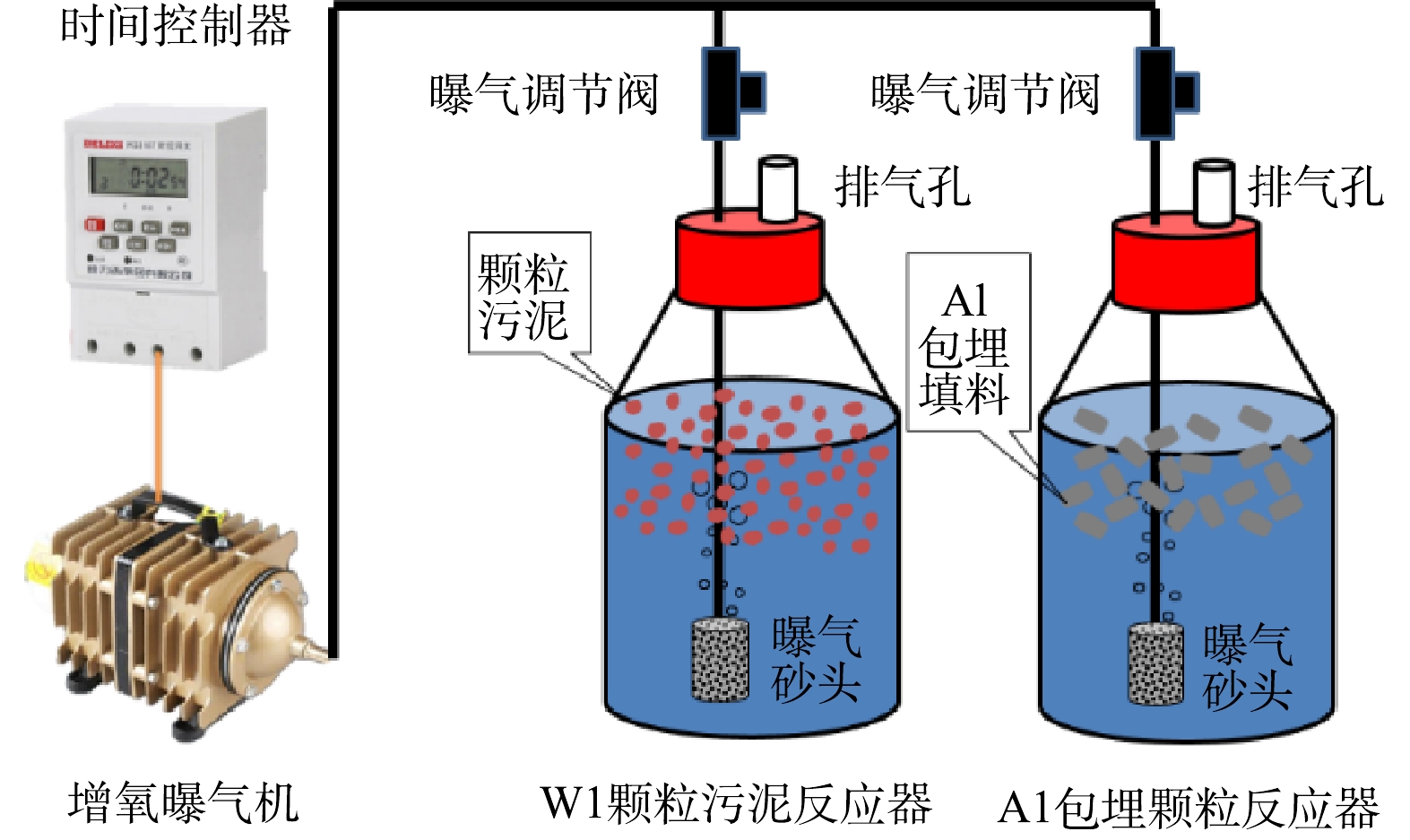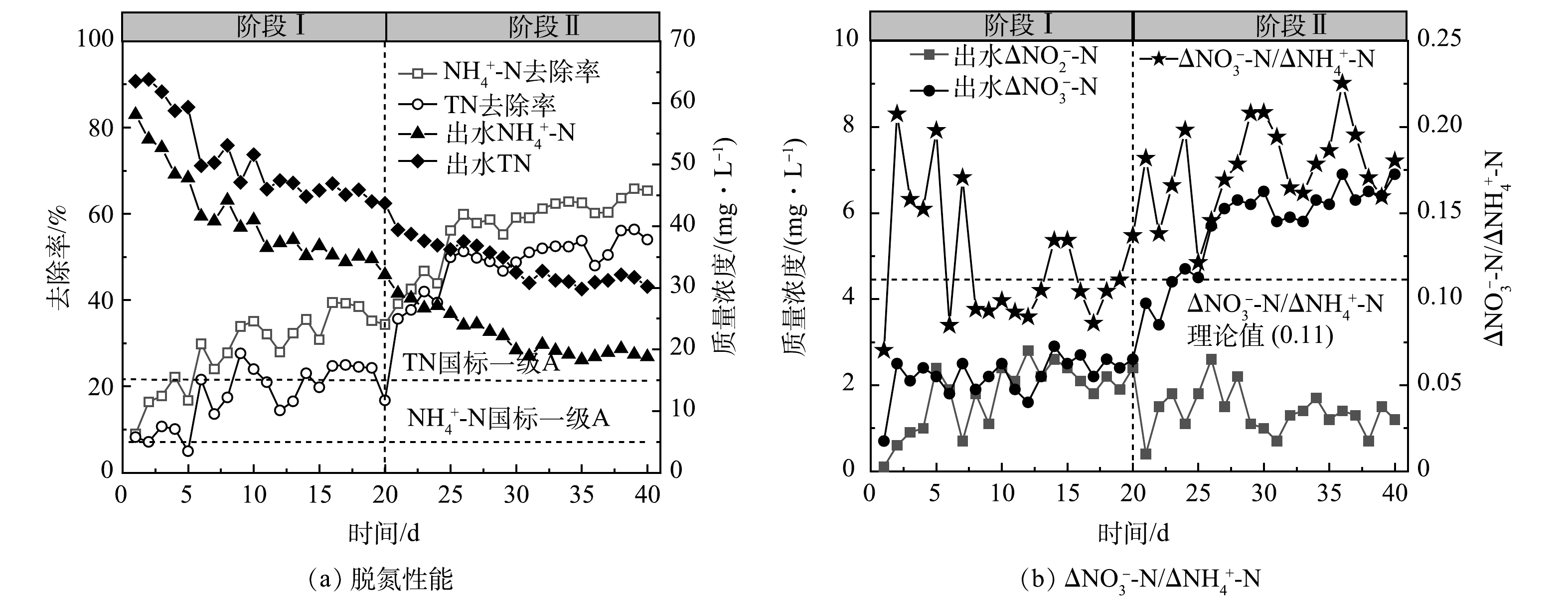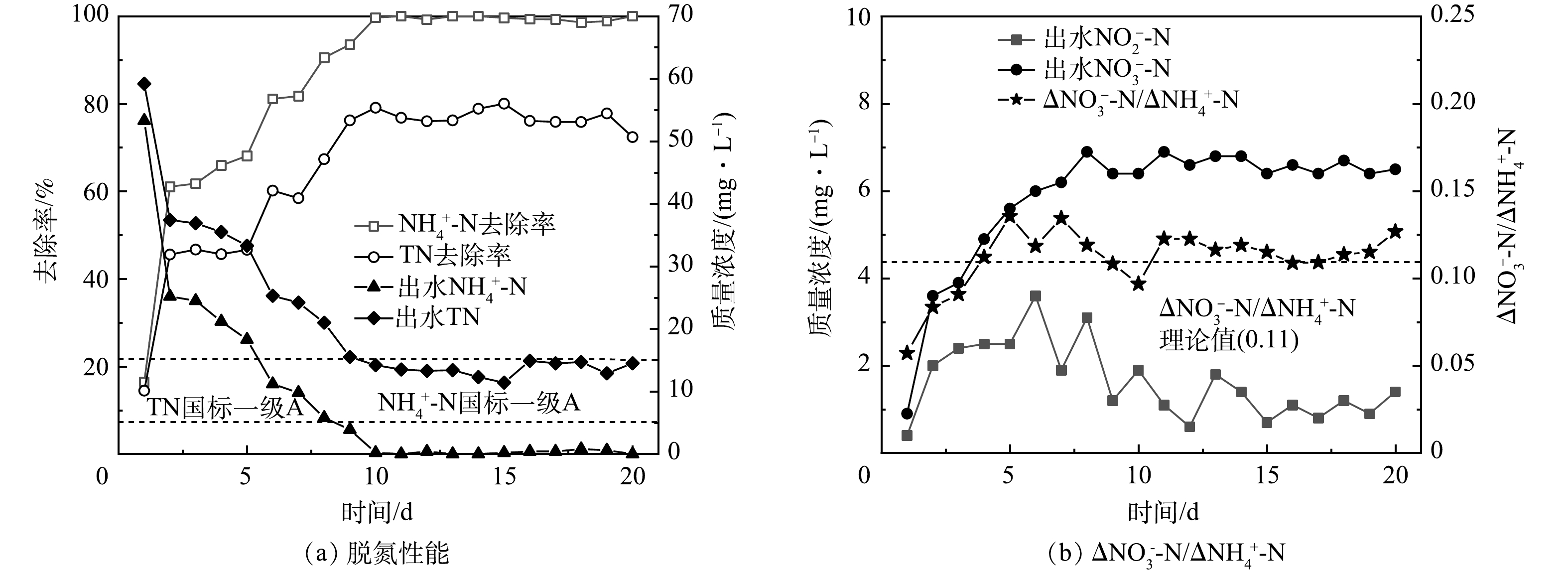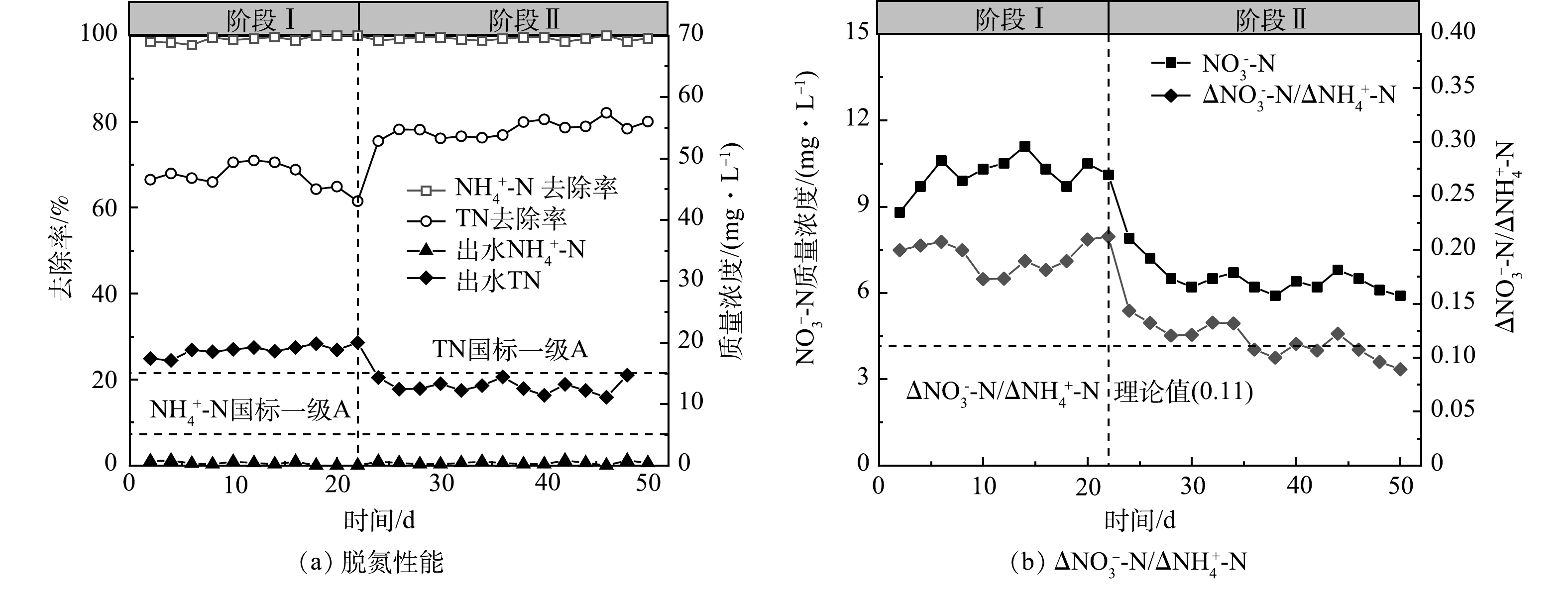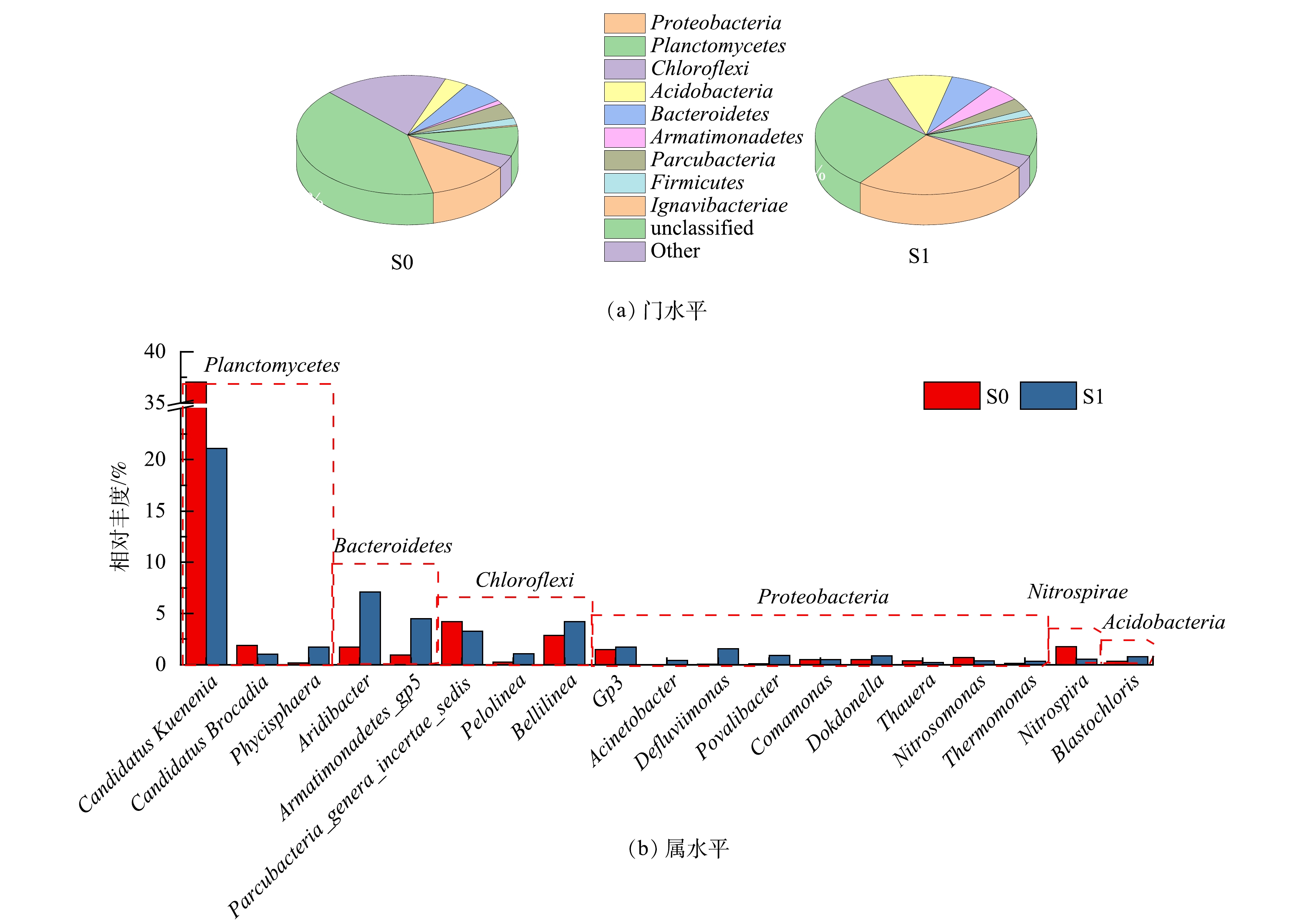-
CANON(completely autotrophic N-removal over nitrite)工艺是近年来提出的新型脱氮工艺,其主要通过控制单级反应器的好氧与厌氧时间,将短程硝化与厌氧氨氧化(Anammox)从时间上进行划分,最终实现在一体反应器中完成脱氮[1-2]。相比传统脱氮工艺,CANON工艺具有能耗低、无需碳源等优势,并在高氨氮废水处理中取得了良好的效果[3-4]。但是,由于城市污水所具有的低氨氮、低温和含有有机物的特点限制了CANON工艺在主流城市污水中的应用[5-7]。一方面,城市污水低温低氨氮的特点不利于短程硝化的维持和厌氧氨氧化菌(AAOB)活性的保持;另一方面,城市污水中的有机物会促进异养菌与氨氧化菌(AOB)及AAOB对于底物的竞争,同时浪费了城市污水中大量的有机碳源。
颗粒污泥可以有效保留功能性微生物(AOB和AAOB),因此,利用颗粒污泥是CANON工艺用于城市污水处理中获得更好性能的一种策略[8-10]。但有研究表明,将成熟的厌氧氨氧化颗粒污泥(AnGS)用于城市污水中后,颗粒污泥多数出现了解体现象并且颗粒中AAOB丰度下降的现象[11-12]。包埋固定化技术在增强细菌密度和减少细菌流失方面优于天然聚集的颗粒污泥[13-14],并且在高氨氮废水处理系统中Anammox包埋填料显示了良好的脱氮效果[15-16]。但是,在低氨氮城市污水中利用Anammox包埋填料脱氮的研究较少。因此,Anammox包埋填料在城市污水条件下的CANON工艺脱氮特性有待进一步研究。
本研究以除碳后的生活污水作为进水,考察了高氨氮废水处理系统中成熟的AnGS及其Anammox包埋填料在生活污水CANON工艺脱氮中的启动,研究了溶解氧(DO)浓度对包埋填料CANON工艺脱氮性能的影响,利用高通量16S rRNA基因测序分析了包埋填料的菌群结构,探究了包埋AnGS用于城市污水CANON工艺脱氮的可行性。
-
厌氧氨氧化颗粒污泥(AnGS)为某味精厂高氨氮废水处理系统中的AnGS(MLSS为7 785 mg·L−1,MLVSS/MLSS为78.6%),其中粒径为2~3 mm的颗粒占90%以上。接种颗粒污泥取回后用蒸馏水清洗3次后平均分为2份备用。随后将其中1份的AnGS放入破碎机中破碎30 s,破碎后的颗粒污泥粒径为0.5~0.7 mm,随后采用课题组成熟的包埋填料制备方法[17]进行Anammox包埋填料A1的制备。首先,将质量含量为20%的聚乙烯醇溶液(PVA,聚合度为2 200,醇解度为20%~99%)和破碎后的AnGS等量混合,并加入碳酸钙粉末和活性炭粉末(小于120目)用于增加填料强度并改善传质,混合均匀后得到水分含量为95%、污泥量(干质量)为4%的混合溶液。随后,在实验室自主研发的挤出设备中制备出直径为1.5 cm、厚度0.3 cm的中空圆筒,在过饱和硼酸溶液中交联后切成0.1 cm长的均匀圆筒型填料。最终在溶液浓度为5%的磷酸三钠溶液中浸泡3 h后用清水洗涤备用,AnGS及Anammox包埋填料实物图见图1。
-
城市污水包埋填料CANON工艺反应器为0.6 L的封口烧瓶,Anammox包埋填料填充率为20%。通过在瓶口开洞后,在烧瓶内加入曝气砂头利用增氧曝气机进行充氧曝气,排气孔使气体能够顺利从反应器中排出,同时DO探头能够从排气孔中伸入反应器中对DO浓度进行监测。运行方式为批次运行,运行周期为8 h,通过时间控制器控制反应器的每周期好氧/缺氧段时间为10 min/20 min,反应器放入30 ℃恒温摇床维持温度,控制摇床转速在80 r·min−1以确保物料均匀。此外,设置AnGS反应器W1作为对照组,W1反应器中生物量与包埋填料反应器中一致,A1包埋填料反应器中的MLSS计算后为12 178 mg·L−1,并且除曝气阶段DO浓度外的运行条件也与A1包埋填料反应器中一致。反应器示意图如图2所示。
城市污水取自北京工业大学西区家属院化粪池上清液,由于生活污水中的有机物会干扰CANON工艺的脱氮性能,因此,在城市污水进水箱中放置曝气盘进行24 h曝气去除有机物,溶解氧质量浓度维持在2~3 mg·L−1,利用城市污水中的异养菌对城市污水中的大部分有机物进行去除,去除后的进水指标见表1。
-
实验分为2部分。第1部分是CANON工艺的启动实验,反应器运行周期为8.0 h。W1颗粒污泥反应器启动分为2个阶段,通过曝气调节阀维持曝气阶段DO质量浓度在2个阶段分别为1.4~1.6 mg·L−1 和2.4~2.6 mg·L−1。由于包埋填料中存在溶解氧传质梯度,反应器中需要较高的DO浓度在能满足包埋填料中AOB对于溶解氧的需求,因此,A1包埋填料反应器在曝气阶段DO质量浓度维持在2.9~3.1 mg·L−1,以考察城市污水条件下的CANON工艺启动。第2部分是DO浓度对包埋填料CANON工艺脱氮的影响实验,反应器运行周期仍维持在8.0 h。实验分为2个阶段,阶段Ⅰ中将A1包埋填料反应器在曝气阶段DO质量浓度提高至3.9~4.1 mg·L−1,阶段Ⅱ中将A1包埋填料反应器在曝气阶段DO质量浓度恢复至2.9~3.1 mg·L−1。
-
水质测定采用国家标准方法[18]: NH4+-N采用纳氏试剂分光光度法;NO2--N采用N-(1-萘基)-乙二胺光度法;NO3--N采用紫外分光光度法;总氮(TN)采用德国 Multi N/C3000 型TN/TOC 分析仪测定;溶解氧(DO)采用HACH HQ30d溶解氧仪测定;pH采用METTLER TOLEDO FE28-Standard分析仪测定。
S0和S1分别为接种AnGS样本和Anammox包埋填料运行后的样本。使用Illumina MiSeq测序平台确定细菌群落结构,引物用于细菌16S rRNA基因的V3-V4高变区的扩增和测序,引物分别为341F(CCTACGGGNGGCWGCAG)和805R (GACTACHVGGGTATCTAATCC)。使用美国国家生物技术信息中心(NCBI)数据库比对细菌的16S rRNA基因序列。对于测序数据,使用MEGAN软件分析环境微生物的16S rRNA基因,并根据一定的阈值对获得的序列进行分类,以将多个序列聚类为可操作的分类单位(OTU),并根据OTU进行多样性分析。
-
W1在城市污水CANON工艺中启动阶段的脱氮特性如图3所示。城市污水进水中NH4+-N质量浓度为46.2~64.7 mg·L−1,TN质量浓度为51.9~69.2 mg·L−1。在阶段Ⅰ中,当反应器曝气阶段DO质量浓度控制为1.4~1.6 mg·L−1,W1反应器的NH4+-N去除率和TN去除率不断提高,在启动过程中,最高NH4+-N去除率和TN去除率分别为39.5%和25.5%,出水最低NH4+-N和TN质量浓度分别为32.1 mg·L−1和43.7 mg·L−1,出水浓度远高于《城镇污水处理厂污染物排放标准(GB 18918-2002)》(以下简称国标)中一级A标准,表明W1颗粒污泥CANON反应器脱氮效率低且增长缓慢。图3(b)反映了W1反应器中ΔNO3−-N/ΔNH4+-N的变化情况。反应器初期由于运行环境的改变导致波动较大,但随着继续运行,反应器的ΔNO3−-N/ΔNH4+-N为0.09~0.13,基本维持在CANON工艺的ΔNO3−-N/ΔNH4+-N的理论值0.11附近[19]。这表明高氨氮废水处理系统中的AnGS在城市污水条件下能维持CANON脱氮途径。同时发现,在阶段Ⅰ中,出水NO3−-N质量浓度始终维持在3 mg·L−1以下,表明CANON工艺中的短程硝化效果良好,并未出现NO3−-N过量积累的现象,而出水NO2−-N同样未出现过量积累也表明Anammox脱氮效果良好。综上所述,W1反应器CANON工艺在阶段Ⅰ中脱氮效果差的主要原因是AOB活性较低,导致NH4+-N向NO2−-N转换速率过慢,无法为Anammox脱氮提供充足底物。
在阶段Ⅱ中,当W1反应器在曝气阶段的DO质量浓度提高至2.4~2.6 mg·L−1后,NH4+-N去除率和TN去除率分别上升至60.1~65.9%和50.5~56.3%,但出水NH4+-N和TN质量浓度最低为18.3 mg·L−1和30.2 mg·L−1,出水仍远高于国标一级A标准。提高曝气阶段的DO浓度虽然能提高W1反应器的氨氧化速率,从而提高NH4+-N和TN去除速率,但出水仍然难以满足排放要求。这是由于AAOB倾向生长于颗粒污泥上,因此,W1反应器在启动过程中的Anammox脱氮效果良好。而AOB、亚硝酸盐氧化菌(NOB)更倾向生长于絮状污泥中,因此导致W1反应器中新生长的AOB和NOB很容易随排水流失,虽然一方面通过污泥流失实现了对NOB的有效淘洗从而促进了短程硝化,但是另一方面也导致AOB的大量流失从而使氨氧化速率难以有效增长,因此即使提高DO浓度也只能促进AOB的活性表达提高反应器的氨氧化速率,但是难以有效维持W1反应器中AOB的菌群数量,最终导致短期内难以实现城市污水CANON工艺高效脱氮。王小龙[20]的研究中同样发现,由于硝化细菌的生长特性,驯化Anammox颗粒污泥向CANON颗粒转化需要较长的启动时间。此外,图3(b)中显示了在DO浓度提高后,W1反应器的ΔNO3−-N/ΔNH4+-N增至0.16~0.22,高于理论值,表明提高DO浓度虽然能够提高氨氧化速率,但同样会破坏短程硝化效果。
A1包埋填料在城市污水CANON工艺中启动阶段的脱氮特性如图4所示。A1包埋填料CANON反应器出水在第10 d后逐渐趋于稳定,在11~20 d反应器的NH4+-N去除率和TN去除率分别为98.9%和72.4%以上,出水NH4+-N和TN质量浓度分别为0~0.8 mg·L−1和11.4~14.5 mg·L−1,出水能够满足国标一级A标准,表明A1包埋填料CANON反应器仅用10 d就成功启动。由于包埋填料能够将细菌固定在填料内部,因此可以大量的减少AOB的流失,同时包埋填料为AOB的生长提供了良好的环境,能够促进AOB在填料内部生长,因此包埋填料相比AnGS能够实现更高的氨氧化速率。此外,包埋填料中的DO传质梯度能够有效抑制NOB的活性,同时也减少了曝气阶段溶解氧对AAOB活性的影响,其他研究中也表明利用包埋固定化技术能够有效促进短程硝化[17, 21]。这些因素的共同作用使得A1包埋填料能够快速启动城市污水CANON工艺。此外,A1包埋填料CANON反应器在启动后的ΔNO3−-N/ΔNH4+-N一直在0.11左右波动,表明了A1包埋填料CANON反应器的良好脱氮特性。
李田等[22]通过同时接种亚硝化污泥和厌氧氨氧化污泥,在模拟除碳生活污水条件下,采取低溶解氧驯化的方式,在55 d内成功启动了CANON工艺。刘竹寒等[23]通过向淹没式生物滤池接种污水处理厂活性污泥,在运行过程中逐渐降低DO浓度,最终在48 d时成功启动了CANON工艺。由于城市污水低氨氮的特点,传统的活性污泥系统往往需要较长的时间驯化硝化菌群和AAOB菌群使其适应城市污水水质。而包埋填料中AOB和AAOB能够根据溶解氧梯度形成良好空间分布[24],同时能够有效减少功能菌群流失,这对于快速启动CANON工艺具有重要作用。在启动过程中,A1包埋填料脱氮能力的增长一方面由于固定化过程中失活的细胞逐步恢复活性,因为包埋过程会对微生物产生毒性而抑制其活性;另一方面则是由于颗粒内微生物的繁殖生长导致脱氮能力提升。WIJFFELS等[25]在固定化颗粒培养过程中发现,微生物的增殖会导致颗粒中的菌落不断膨胀,并且由于传质作用,靠近颗粒表面的微生物比位于中心部位的微生物的增殖速率快得多,随着增长的微生物触及载体颗粒表面,并由表面泄漏到溶液中去,最终随着微生物的不断增长整个颗粒内的生物量达到一个稳定值。因此,对于A1包埋填料,当填料中的微生物量达到峰值后,增殖的微生物会通过填料表面进入溶液中并排出,这也表明了在进水负荷不变的条件下,A1包埋填料在启动成功后脱氮能力并未进一步增长主要是由于填料内的生物量达到了稳定值。此外,由于包埋填料传质的影响,填料内部基质较低,可能会出现由于基质缺乏导致的微生物衰亡,最终微生物分解后填料内部形成类似大颗粒污泥内部的“空腔”。但是,通过降低接种AnGS粒径增强了包埋填料在城市污水低浓度条件下的传质,有效减少了填料内部微生物的衰亡。
-
由图5可以看出,在阶段Ⅰ中,当A1包埋填料CANON反应器在曝气阶段的DO质量浓度由2.9~3.1 mg·L−1提升至3.9~4.1 mg·L−1后,A1包埋填料反应器的TN去除率迅速下降至61.9%~70.9%,同时出水TN质量浓度增长至17.1~20.0 mg·L−1。表明提高A1包埋填料曝气阶段的DO浓度会导致脱氮性能变化。同时,NH4+-N去除率仍维持在97.3%以上,表明DO浓度的提高并未影响A1包埋填料对城市污水中的氨氮的去除效果。由图5(b)可见,出水NO3−-N在DO质量浓度提高后迅速增长至9.7~11.1 mg·L−1,同时反应器ΔNO3−-N/ΔNH4+-N增长至0.17~0.21,远高于CANON工艺脱氮的理论值。这表明A1包埋填料由于曝气阶段DO浓度提高导致CANON工艺的短程硝化破坏,出水NO3−-N增加导致出水TN不达标。溶解氧在A1包埋填料中的传质分为2个部分,一部分是是填料表面到颗粒外层形成的传质梯度,此时包埋填料中游离的AOB和NOB在这个传质梯度中利用溶解氧;另一部分是颗粒外层到颗粒内层形成的传质梯度,此时颗粒内的AOB和NOB在这个传质梯度中利用溶解氧。因此,当A1包埋填料CANON工艺中的DO质量浓度提高后,包埋填料中游离的NOB和颗粒中的NOB的活性提高导致短程硝化破坏。此外,HAN等[26]的研究中发现不同粒径颗粒污泥中溶解氧浓度分布差异较大,随着粒径的增大,颗粒内部的DO质量浓度越低,由于A1包埋填料的接种污泥为小颗粒,因此,高DO环境不利于抑制包埋填料颗粒中的NOB活性。
在阶段Ⅱ中,当A1包埋填料反应器在曝气阶段的DO质量浓度恢复至2.9~3.1 mg·L−1后,反应器中TN去除率提升至75.5~82.0%,出水TN质量浓度降低至11.4~14.3 mg·L−1,出水NO3−-N质量浓度降低至5.9~7.9 mg·L−1,ΔNO3−-N/ΔNH4+-N同样恢复至0.11左右。这表明短期的高DO运行并不会破坏CANON工艺的脱氮效果。黄鹏飞等[27]的研究同样表明,在高DO的条件下,CANON工艺脱稳失活,但通过降低反应器中的DO质量浓度,能够恢复CANON工艺脱氮效果。上述实验结果表明,合理控制包埋填料反应器的DO质量浓度从而实现稳定的短程硝化是实现包埋填料城市污水CANON工艺脱氮的关键。
-
1)微生物多样性。表2反映了接种AnGS和A1包埋填料在城市污水CANON工艺运行后的菌群多样性,由表2中可以看出,高氨氮废水处理系统中的AnGS在制成A1包埋填料且在城市污水CANON工艺运行后,ACE和Chao1指数在运行后上升,而Simpson指数下降。这表明A1包埋填料在城市污水CANON工艺运行后的微生物多样性高于接种AnGS。一方面在包埋填料制作过程中使AnGS的粒径减小,改变了不同微生物的生态环境,导致菌群多样性改变[28];另一方面,城市污水条件的复杂水质条件和间歇曝气的运行方式改变了原有AnGS的运行环境,导致了其他功能微生物的生长,从而增加了微生物的多样性。
2)微生物多样性。样本门和属水平的微生物群落多样性如图6所示。由图6可以看出,接种AnGS样本S0在门水平的主要菌属为浮霉菌门(Planctomycetes),占全菌属中的41.36%,随后依次是绿弯菌门(Chloroflexi)占比17.97%,变形菌门(Proteobacteria)占比12.09%,拟杆菌门(Bacteroidetes)占比6.15%,酸杆菌门(Acidobacteria)占比3.47%,S0在门水平上的构成属于典型Anammox系统[29-30]。当接种AnGS制成包埋填料用于城市污水CANON工艺脱氮运行后,变形菌门占比上升至26.13%,成为主要菌属,涉及氨氮转化的硝化菌属以及反硝化脱氮的相关菌属均属于此菌属。DU等[31]的研究同样表明,利用成熟的Anammox系统对城市污水进行脱氮后,Anammox系统中的主要菌属为变形菌门。这表明城市污水CANON工艺条件促进了Anammox脱氮系统其他相关菌群的生长。同时,AAOB所属的浮霉菌门占比下降至25.95%,成为占比第2的菌属。这表明包埋填料中的AAOB菌群即使在低氨氮的城市污水中仍能维持一定的菌群优势。
属水平的聚类分析更清晰地显示出接种AnGS制成包埋填料后在CANON工艺运行后的菌群变化。S0接种AnGS中的主要AAOB菌属为Candidatus Kuenenia和Candidatus Brocadia,这2种菌属均为污水处理系统中常见的厌氧氨氧化菌属[32]。运行后的S1样本中Candidatus Kuenenia和Candidatus Brocadia占比分别由37.02%和1.88%分别降低至21.11%和1.04%,虽然AAOB占比降低,但仍是A1包埋填料中的占比最高的优势菌群,这表明包埋填料能够维持AAOB在城市污水条件下的菌群优势。PVA载体具有多孔结构、良好的生物相容性和扩散性[33],因此是包埋AAOB的理想载体。此外,包埋填料的接种AnGS用于处理高氨氮废水,在高浓度条件下,大颗粒有助于提高系统的脱氮性能并抵御冲击负荷带来的不利影响[9]。但针对低浓度的城市污水,大颗粒不利于传质,因此,通过破碎成小颗粒的方式,能够提高AAOB对低基质的利用。包埋填料为小颗粒结构中的AAOB在城市污水中提供了良好的微环境,从而保持了AAOB的菌群优势。
除AAOB外,A1包埋填料中与氮转化有关的细菌还包括硝化细菌群和反硝化细菌群,它们共同对城市污水CANON脱氮过程产生影响。运行后的A1包埋填料中的主要AOB菌属为Nitrosomonas,是污水处理系统中最常见的AOB菌属[34],占比为0.37%。主要NOB菌属为Nitrospira,占比为0.53%。Nitrospira属于K-strategists型细菌,更容易在低底物条件下生长。LIU等[35]发现长期低溶解氧运行的生物反应器中主要NOB菌属为Nitrospira,这表明即使包埋填料反应器中的DO浓度维持在较高水平,但是包埋填料内仍能维持较低的DO浓度,同时由于间歇曝气的运行方式能够进一步抑制NOB的活性,因此A1包埋填料中的NOB丰度在城市污水CANON工艺中维持在较低水平。此外,A1包埋填料中的主要反硝化菌属为Comamonas、Thermomonas和Thauera,占比由接种AnGS中的0.5%、0.37%和0.13%分别变为0.49%、0.2%和0.35%,表明反硝化菌群并未出现明显变化,这是由于城市污水经过除碳后,进水中有机物浓度较低,因此削弱了反硝化对CANON工艺脱氮的影响。
-
1)以去除有机物后的城市污水作为进水,通过间歇曝气的运行方式成功启动了AnGS包埋填料的CANON工艺,出水NH4+-N和TN均能满足国标一级A的要求,与AnGS系统的处理效果对比表明,包埋固定化技术在减少功能菌群(AOB和AAOB)流失和提高功能菌群活性方面的优势是实现CANON工艺在城市污水条件下快速启动的关键。
2)合理控制包埋填料反应器的DO浓度从而实现稳定的短程硝化是实现包埋填料城市污水CANON工艺脱氮的关键,并且短期的高DO冲击运行并不会破坏包埋填料CANON工艺的脱氮效果。
3)城市污水CANON工艺运行前后的高通量检测结果表明,包埋填料在城市污水中能够在保持AAOB菌群优势的同时有效抑制NOB的增长,包埋固定化技术可为在城市污水条件下实现CANON工艺脱氮提供参考。
包埋厌氧氨氧化颗粒污泥的生活污水CANON工艺脱氮特性
Nitrogen removal characteristics of immobilization of Anammox granular sludge in domestic sewage CANON process
-
摘要: 为实现厌氧氨氧化(Anammox)包埋填料在城市污水中的稳定脱氮,以除碳后的生活污水作为进水,通过间歇曝气的运行方式,研究了高氨氮废水处理系统中的厌氧氨氧化颗粒污泥(AnGS)及利用其制成的Anammox包埋填料在生活污水CANON工艺中的脱氮性能及微生物群落结构。结果表明,在生活污水CANON工艺启动过程中,AnGS系统的氨氮去除率和总氮去除率最高分别仅为65.9%和59.3%,而包埋填料后在启动仅10 d后,氨氮去除率和总氮去除率分别可达98.9%和72.4%以上,同时出水NH4+-N和TN均能满足《城镇污水处理厂污染物排放标准(GB 18918-2002)》中一级A的排放要求。提高曝气阶段的DO质量浓度(2.9~3.1 mg·L−1提升到3.9~4.1 mg·L−1)会导致包埋填料出水NO3−-N 质量浓度增长至9.7~11.1 mg·L−1,从而破坏CANON工艺中的短程硝化导致出水总氮不达标。但将DO浓度恢复后,包埋填料CANON工艺的脱氮效果能够恢复。运行后的包埋填料中AAOB主要菌属Candidatus Kuenenia和Candidatus Brocadia的占比为21.11%和1.04%,同时NOB主要菌属为Nitrospira,占比仅为0.53%,包埋填料在生活污水中能够保持AAOB菌群优势并有效抑制NOB的增长,因此将包埋固定化技术用于城市污水CANON工艺脱氮中具有广阔的前景。
-
关键词:
- 厌氧氨氧化(Anammox) /
- 固定化 /
- CANON /
- 微生物群落结构 /
- 生活污水
Abstract: In order to achieve the stable nitrogen removal of Anammox immobilized filler in domestic sewage, the decarbonized domestic sewage was used as the feed water, the aeration method was intermittent aeration, the nitrogen removal performance and microbial community structure of anaerobic ammonia oxidation granular sludge (AnGS) in the high ammonia wastewater treatment system and the Anammox immobilized filler made of AnGS in the CANON process of municipal wastewater were studied. The results showed that during the start-up of the CANON process of domestic sewage, the highest removal rates of ammonia and total nitrogen in the AnGS system were only 65.9% and 59.3%, respectively. After 10 days of start-up of the immobilized filler, the removal rates of ammonia and total nitrogen could reach over 98.9% and 72.4%, respectively, and the effluent NH4+-N and TN could meet the discharge requirements of level A in the “Emission Standard for Pollutants for Urban Wastewater Treatment Plants (GB 18918-2002)”. Increasing the DO concentration in the aeration stage (from 2.9~3.1 mg·L−1 to 3.9~4.1 mg·L−1) resulted in the increase of the effluent NO3−-N of the immobilized filler to 9.7~11.1 mg·L−1, thus the short-cut nitrification of the CANON process was destroyed and the effluent total nitrogen did not meet the standard accordingly. However, after the DO concentration was returned to previous value, the nitrogen removal effect of the immobilized filler CANON process could recover. After the immobilized filler operation, the main AAOB bacteria were Candidatus Kuenenia and Candidatus Brocadia, accounted for 21.11% and 1.04%, respectively, while the main NOB bacterium was Nitrospira, accounting for only 0.53%. Immobilized filler can maintain the advantages of the AAOB flora in domestic sewage and inhibit the growth of NOB, so the immobilization technology has broad prospects for the nitrogen removal from municipal wastewater by CANON process. -
CANON(completely autotrophic N-removal over nitrite)工艺是近年来提出的新型脱氮工艺,其主要通过控制单级反应器的好氧与厌氧时间,将短程硝化与厌氧氨氧化(Anammox)从时间上进行划分,最终实现在一体反应器中完成脱氮[1-2]。相比传统脱氮工艺,CANON工艺具有能耗低、无需碳源等优势,并在高氨氮废水处理中取得了良好的效果[3-4]。但是,由于城市污水所具有的低氨氮、低温和含有有机物的特点限制了CANON工艺在主流城市污水中的应用[5-7]。一方面,城市污水低温低氨氮的特点不利于短程硝化的维持和厌氧氨氧化菌(AAOB)活性的保持;另一方面,城市污水中的有机物会促进异养菌与氨氧化菌(AOB)及AAOB对于底物的竞争,同时浪费了城市污水中大量的有机碳源。
颗粒污泥可以有效保留功能性微生物(AOB和AAOB),因此,利用颗粒污泥是CANON工艺用于城市污水处理中获得更好性能的一种策略[8-10]。但有研究表明,将成熟的厌氧氨氧化颗粒污泥(AnGS)用于城市污水中后,颗粒污泥多数出现了解体现象并且颗粒中AAOB丰度下降的现象[11-12]。包埋固定化技术在增强细菌密度和减少细菌流失方面优于天然聚集的颗粒污泥[13-14],并且在高氨氮废水处理系统中Anammox包埋填料显示了良好的脱氮效果[15-16]。但是,在低氨氮城市污水中利用Anammox包埋填料脱氮的研究较少。因此,Anammox包埋填料在城市污水条件下的CANON工艺脱氮特性有待进一步研究。
本研究以除碳后的生活污水作为进水,考察了高氨氮废水处理系统中成熟的AnGS及其Anammox包埋填料在生活污水CANON工艺脱氮中的启动,研究了溶解氧(DO)浓度对包埋填料CANON工艺脱氮性能的影响,利用高通量16S rRNA基因测序分析了包埋填料的菌群结构,探究了包埋AnGS用于城市污水CANON工艺脱氮的可行性。
1. 材料与方法
1.1 污泥来源及包埋填料制备
厌氧氨氧化颗粒污泥(AnGS)为某味精厂高氨氮废水处理系统中的AnGS(MLSS为7 785 mg·L−1,MLVSS/MLSS为78.6%),其中粒径为2~3 mm的颗粒占90%以上。接种颗粒污泥取回后用蒸馏水清洗3次后平均分为2份备用。随后将其中1份的AnGS放入破碎机中破碎30 s,破碎后的颗粒污泥粒径为0.5~0.7 mm,随后采用课题组成熟的包埋填料制备方法[17]进行Anammox包埋填料A1的制备。首先,将质量含量为20%的聚乙烯醇溶液(PVA,聚合度为2 200,醇解度为20%~99%)和破碎后的AnGS等量混合,并加入碳酸钙粉末和活性炭粉末(小于120目)用于增加填料强度并改善传质,混合均匀后得到水分含量为95%、污泥量(干质量)为4%的混合溶液。随后,在实验室自主研发的挤出设备中制备出直径为1.5 cm、厚度0.3 cm的中空圆筒,在过饱和硼酸溶液中交联后切成0.1 cm长的均匀圆筒型填料。最终在溶液浓度为5%的磷酸三钠溶液中浸泡3 h后用清水洗涤备用,AnGS及Anammox包埋填料实物图见图1。
1.2 实验装置及实验用水
城市污水包埋填料CANON工艺反应器为0.6 L的封口烧瓶,Anammox包埋填料填充率为20%。通过在瓶口开洞后,在烧瓶内加入曝气砂头利用增氧曝气机进行充氧曝气,排气孔使气体能够顺利从反应器中排出,同时DO探头能够从排气孔中伸入反应器中对DO浓度进行监测。运行方式为批次运行,运行周期为8 h,通过时间控制器控制反应器的每周期好氧/缺氧段时间为10 min/20 min,反应器放入30 ℃恒温摇床维持温度,控制摇床转速在80 r·min−1以确保物料均匀。此外,设置AnGS反应器W1作为对照组,W1反应器中生物量与包埋填料反应器中一致,A1包埋填料反应器中的MLSS计算后为12 178 mg·L−1,并且除曝气阶段DO浓度外的运行条件也与A1包埋填料反应器中一致。反应器示意图如图2所示。
城市污水取自北京工业大学西区家属院化粪池上清液,由于生活污水中的有机物会干扰CANON工艺的脱氮性能,因此,在城市污水进水箱中放置曝气盘进行24 h曝气去除有机物,溶解氧质量浓度维持在2~3 mg·L−1,利用城市污水中的异养菌对城市污水中的大部分有机物进行去除,去除后的进水指标见表1。
表 1 CANON反应器进水水质指标Table 1. Characteristics of the influent of CANON reactor统计值 碳氮质量浓度/(mg·L−1) C/N比 pH COD TN NH4+-N NO2−-N NO3−-N 范围 43.2~61.5 52.0~69.2 46.2~64.7 0.2~0.7 0.2~1.1 0.9~1.5 7.7~7.9 平均值 56.8 59.9 55.2 0.4 0.9 1.2 7.8 1.3 实验方法
实验分为2部分。第1部分是CANON工艺的启动实验,反应器运行周期为8.0 h。W1颗粒污泥反应器启动分为2个阶段,通过曝气调节阀维持曝气阶段DO质量浓度在2个阶段分别为1.4~1.6 mg·L−1 和2.4~2.6 mg·L−1。由于包埋填料中存在溶解氧传质梯度,反应器中需要较高的DO浓度在能满足包埋填料中AOB对于溶解氧的需求,因此,A1包埋填料反应器在曝气阶段DO质量浓度维持在2.9~3.1 mg·L−1,以考察城市污水条件下的CANON工艺启动。第2部分是DO浓度对包埋填料CANON工艺脱氮的影响实验,反应器运行周期仍维持在8.0 h。实验分为2个阶段,阶段Ⅰ中将A1包埋填料反应器在曝气阶段DO质量浓度提高至3.9~4.1 mg·L−1,阶段Ⅱ中将A1包埋填料反应器在曝气阶段DO质量浓度恢复至2.9~3.1 mg·L−1。
1.4 检测项目及方法
水质测定采用国家标准方法[18]: NH4+-N采用纳氏试剂分光光度法;NO2--N采用N-(1-萘基)-乙二胺光度法;NO3--N采用紫外分光光度法;总氮(TN)采用德国 Multi N/C3000 型TN/TOC 分析仪测定;溶解氧(DO)采用HACH HQ30d溶解氧仪测定;pH采用METTLER TOLEDO FE28-Standard分析仪测定。
S0和S1分别为接种AnGS样本和Anammox包埋填料运行后的样本。使用Illumina MiSeq测序平台确定细菌群落结构,引物用于细菌16S rRNA基因的V3-V4高变区的扩增和测序,引物分别为341F(CCTACGGGNGGCWGCAG)和805R (GACTACHVGGGTATCTAATCC)。使用美国国家生物技术信息中心(NCBI)数据库比对细菌的16S rRNA基因序列。对于测序数据,使用MEGAN软件分析环境微生物的16S rRNA基因,并根据一定的阈值对获得的序列进行分类,以将多个序列聚类为可操作的分类单位(OTU),并根据OTU进行多样性分析。
2. 结果与讨论
2.1 城市污水CANON工艺的启动
W1在城市污水CANON工艺中启动阶段的脱氮特性如图3所示。城市污水进水中NH4+-N质量浓度为46.2~64.7 mg·L−1,TN质量浓度为51.9~69.2 mg·L−1。在阶段Ⅰ中,当反应器曝气阶段DO质量浓度控制为1.4~1.6 mg·L−1,W1反应器的NH4+-N去除率和TN去除率不断提高,在启动过程中,最高NH4+-N去除率和TN去除率分别为39.5%和25.5%,出水最低NH4+-N和TN质量浓度分别为32.1 mg·L−1和43.7 mg·L−1,出水浓度远高于《城镇污水处理厂污染物排放标准(GB 18918-2002)》(以下简称国标)中一级A标准,表明W1颗粒污泥CANON反应器脱氮效率低且增长缓慢。图3(b)反映了W1反应器中ΔNO3−-N/ΔNH4+-N的变化情况。反应器初期由于运行环境的改变导致波动较大,但随着继续运行,反应器的ΔNO3−-N/ΔNH4+-N为0.09~0.13,基本维持在CANON工艺的ΔNO3−-N/ΔNH4+-N的理论值0.11附近[19]。这表明高氨氮废水处理系统中的AnGS在城市污水条件下能维持CANON脱氮途径。同时发现,在阶段Ⅰ中,出水NO3−-N质量浓度始终维持在3 mg·L−1以下,表明CANON工艺中的短程硝化效果良好,并未出现NO3−-N过量积累的现象,而出水NO2−-N同样未出现过量积累也表明Anammox脱氮效果良好。综上所述,W1反应器CANON工艺在阶段Ⅰ中脱氮效果差的主要原因是AOB活性较低,导致NH4+-N向NO2−-N转换速率过慢,无法为Anammox脱氮提供充足底物。
在阶段Ⅱ中,当W1反应器在曝气阶段的DO质量浓度提高至2.4~2.6 mg·L−1后,NH4+-N去除率和TN去除率分别上升至60.1~65.9%和50.5~56.3%,但出水NH4+-N和TN质量浓度最低为18.3 mg·L−1和30.2 mg·L−1,出水仍远高于国标一级A标准。提高曝气阶段的DO浓度虽然能提高W1反应器的氨氧化速率,从而提高NH4+-N和TN去除速率,但出水仍然难以满足排放要求。这是由于AAOB倾向生长于颗粒污泥上,因此,W1反应器在启动过程中的Anammox脱氮效果良好。而AOB、亚硝酸盐氧化菌(NOB)更倾向生长于絮状污泥中,因此导致W1反应器中新生长的AOB和NOB很容易随排水流失,虽然一方面通过污泥流失实现了对NOB的有效淘洗从而促进了短程硝化,但是另一方面也导致AOB的大量流失从而使氨氧化速率难以有效增长,因此即使提高DO浓度也只能促进AOB的活性表达提高反应器的氨氧化速率,但是难以有效维持W1反应器中AOB的菌群数量,最终导致短期内难以实现城市污水CANON工艺高效脱氮。王小龙[20]的研究中同样发现,由于硝化细菌的生长特性,驯化Anammox颗粒污泥向CANON颗粒转化需要较长的启动时间。此外,图3(b)中显示了在DO浓度提高后,W1反应器的ΔNO3−-N/ΔNH4+-N增至0.16~0.22,高于理论值,表明提高DO浓度虽然能够提高氨氧化速率,但同样会破坏短程硝化效果。
A1包埋填料在城市污水CANON工艺中启动阶段的脱氮特性如图4所示。A1包埋填料CANON反应器出水在第10 d后逐渐趋于稳定,在11~20 d反应器的NH4+-N去除率和TN去除率分别为98.9%和72.4%以上,出水NH4+-N和TN质量浓度分别为0~0.8 mg·L−1和11.4~14.5 mg·L−1,出水能够满足国标一级A标准,表明A1包埋填料CANON反应器仅用10 d就成功启动。由于包埋填料能够将细菌固定在填料内部,因此可以大量的减少AOB的流失,同时包埋填料为AOB的生长提供了良好的环境,能够促进AOB在填料内部生长,因此包埋填料相比AnGS能够实现更高的氨氧化速率。此外,包埋填料中的DO传质梯度能够有效抑制NOB的活性,同时也减少了曝气阶段溶解氧对AAOB活性的影响,其他研究中也表明利用包埋固定化技术能够有效促进短程硝化[17, 21]。这些因素的共同作用使得A1包埋填料能够快速启动城市污水CANON工艺。此外,A1包埋填料CANON反应器在启动后的ΔNO3−-N/ΔNH4+-N一直在0.11左右波动,表明了A1包埋填料CANON反应器的良好脱氮特性。
李田等[22]通过同时接种亚硝化污泥和厌氧氨氧化污泥,在模拟除碳生活污水条件下,采取低溶解氧驯化的方式,在55 d内成功启动了CANON工艺。刘竹寒等[23]通过向淹没式生物滤池接种污水处理厂活性污泥,在运行过程中逐渐降低DO浓度,最终在48 d时成功启动了CANON工艺。由于城市污水低氨氮的特点,传统的活性污泥系统往往需要较长的时间驯化硝化菌群和AAOB菌群使其适应城市污水水质。而包埋填料中AOB和AAOB能够根据溶解氧梯度形成良好空间分布[24],同时能够有效减少功能菌群流失,这对于快速启动CANON工艺具有重要作用。在启动过程中,A1包埋填料脱氮能力的增长一方面由于固定化过程中失活的细胞逐步恢复活性,因为包埋过程会对微生物产生毒性而抑制其活性;另一方面则是由于颗粒内微生物的繁殖生长导致脱氮能力提升。WIJFFELS等[25]在固定化颗粒培养过程中发现,微生物的增殖会导致颗粒中的菌落不断膨胀,并且由于传质作用,靠近颗粒表面的微生物比位于中心部位的微生物的增殖速率快得多,随着增长的微生物触及载体颗粒表面,并由表面泄漏到溶液中去,最终随着微生物的不断增长整个颗粒内的生物量达到一个稳定值。因此,对于A1包埋填料,当填料中的微生物量达到峰值后,增殖的微生物会通过填料表面进入溶液中并排出,这也表明了在进水负荷不变的条件下,A1包埋填料在启动成功后脱氮能力并未进一步增长主要是由于填料内的生物量达到了稳定值。此外,由于包埋填料传质的影响,填料内部基质较低,可能会出现由于基质缺乏导致的微生物衰亡,最终微生物分解后填料内部形成类似大颗粒污泥内部的“空腔”。但是,通过降低接种AnGS粒径增强了包埋填料在城市污水低浓度条件下的传质,有效减少了填料内部微生物的衰亡。
2.2 DO浓度对城市污水包埋填料CANON工艺中脱氮性能的影响
由图5可以看出,在阶段Ⅰ中,当A1包埋填料CANON反应器在曝气阶段的DO质量浓度由2.9~3.1 mg·L−1提升至3.9~4.1 mg·L−1后,A1包埋填料反应器的TN去除率迅速下降至61.9%~70.9%,同时出水TN质量浓度增长至17.1~20.0 mg·L−1。表明提高A1包埋填料曝气阶段的DO浓度会导致脱氮性能变化。同时,NH4+-N去除率仍维持在97.3%以上,表明DO浓度的提高并未影响A1包埋填料对城市污水中的氨氮的去除效果。由图5(b)可见,出水NO3−-N在DO质量浓度提高后迅速增长至9.7~11.1 mg·L−1,同时反应器ΔNO3−-N/ΔNH4+-N增长至0.17~0.21,远高于CANON工艺脱氮的理论值。这表明A1包埋填料由于曝气阶段DO浓度提高导致CANON工艺的短程硝化破坏,出水NO3−-N增加导致出水TN不达标。溶解氧在A1包埋填料中的传质分为2个部分,一部分是是填料表面到颗粒外层形成的传质梯度,此时包埋填料中游离的AOB和NOB在这个传质梯度中利用溶解氧;另一部分是颗粒外层到颗粒内层形成的传质梯度,此时颗粒内的AOB和NOB在这个传质梯度中利用溶解氧。因此,当A1包埋填料CANON工艺中的DO质量浓度提高后,包埋填料中游离的NOB和颗粒中的NOB的活性提高导致短程硝化破坏。此外,HAN等[26]的研究中发现不同粒径颗粒污泥中溶解氧浓度分布差异较大,随着粒径的增大,颗粒内部的DO质量浓度越低,由于A1包埋填料的接种污泥为小颗粒,因此,高DO环境不利于抑制包埋填料颗粒中的NOB活性。
在阶段Ⅱ中,当A1包埋填料反应器在曝气阶段的DO质量浓度恢复至2.9~3.1 mg·L−1后,反应器中TN去除率提升至75.5~82.0%,出水TN质量浓度降低至11.4~14.3 mg·L−1,出水NO3−-N质量浓度降低至5.9~7.9 mg·L−1,ΔNO3−-N/ΔNH4+-N同样恢复至0.11左右。这表明短期的高DO运行并不会破坏CANON工艺的脱氮效果。黄鹏飞等[27]的研究同样表明,在高DO的条件下,CANON工艺脱稳失活,但通过降低反应器中的DO质量浓度,能够恢复CANON工艺脱氮效果。上述实验结果表明,合理控制包埋填料反应器的DO质量浓度从而实现稳定的短程硝化是实现包埋填料城市污水CANON工艺脱氮的关键。
2.3 包埋填料在城市污水CANON工艺运行后的菌群分析
1)微生物多样性。表2反映了接种AnGS和A1包埋填料在城市污水CANON工艺运行后的菌群多样性,由表2中可以看出,高氨氮废水处理系统中的AnGS在制成A1包埋填料且在城市污水CANON工艺运行后,ACE和Chao1指数在运行后上升,而Simpson指数下降。这表明A1包埋填料在城市污水CANON工艺运行后的微生物多样性高于接种AnGS。一方面在包埋填料制作过程中使AnGS的粒径减小,改变了不同微生物的生态环境,导致菌群多样性改变[28];另一方面,城市污水条件的复杂水质条件和间歇曝气的运行方式改变了原有AnGS的运行环境,导致了其他功能微生物的生长,从而增加了微生物的多样性。
表 2 微生物多样性评估Table 2. Microbial diversity assessment样本名称 序列数 OUT数 ACE指数 Chao1指数 Simpson指数 S0 55 901 1 395 1 705.56 1 624.73 0.12 S1 41 417 2 621 19 118.57 10 527.83 0.06 2)微生物多样性。样本门和属水平的微生物群落多样性如图6所示。由图6可以看出,接种AnGS样本S0在门水平的主要菌属为浮霉菌门(Planctomycetes),占全菌属中的41.36%,随后依次是绿弯菌门(Chloroflexi)占比17.97%,变形菌门(Proteobacteria)占比12.09%,拟杆菌门(Bacteroidetes)占比6.15%,酸杆菌门(Acidobacteria)占比3.47%,S0在门水平上的构成属于典型Anammox系统[29-30]。当接种AnGS制成包埋填料用于城市污水CANON工艺脱氮运行后,变形菌门占比上升至26.13%,成为主要菌属,涉及氨氮转化的硝化菌属以及反硝化脱氮的相关菌属均属于此菌属。DU等[31]的研究同样表明,利用成熟的Anammox系统对城市污水进行脱氮后,Anammox系统中的主要菌属为变形菌门。这表明城市污水CANON工艺条件促进了Anammox脱氮系统其他相关菌群的生长。同时,AAOB所属的浮霉菌门占比下降至25.95%,成为占比第2的菌属。这表明包埋填料中的AAOB菌群即使在低氨氮的城市污水中仍能维持一定的菌群优势。
属水平的聚类分析更清晰地显示出接种AnGS制成包埋填料后在CANON工艺运行后的菌群变化。S0接种AnGS中的主要AAOB菌属为Candidatus Kuenenia和Candidatus Brocadia,这2种菌属均为污水处理系统中常见的厌氧氨氧化菌属[32]。运行后的S1样本中Candidatus Kuenenia和Candidatus Brocadia占比分别由37.02%和1.88%分别降低至21.11%和1.04%,虽然AAOB占比降低,但仍是A1包埋填料中的占比最高的优势菌群,这表明包埋填料能够维持AAOB在城市污水条件下的菌群优势。PVA载体具有多孔结构、良好的生物相容性和扩散性[33],因此是包埋AAOB的理想载体。此外,包埋填料的接种AnGS用于处理高氨氮废水,在高浓度条件下,大颗粒有助于提高系统的脱氮性能并抵御冲击负荷带来的不利影响[9]。但针对低浓度的城市污水,大颗粒不利于传质,因此,通过破碎成小颗粒的方式,能够提高AAOB对低基质的利用。包埋填料为小颗粒结构中的AAOB在城市污水中提供了良好的微环境,从而保持了AAOB的菌群优势。
除AAOB外,A1包埋填料中与氮转化有关的细菌还包括硝化细菌群和反硝化细菌群,它们共同对城市污水CANON脱氮过程产生影响。运行后的A1包埋填料中的主要AOB菌属为Nitrosomonas,是污水处理系统中最常见的AOB菌属[34],占比为0.37%。主要NOB菌属为Nitrospira,占比为0.53%。Nitrospira属于K-strategists型细菌,更容易在低底物条件下生长。LIU等[35]发现长期低溶解氧运行的生物反应器中主要NOB菌属为Nitrospira,这表明即使包埋填料反应器中的DO浓度维持在较高水平,但是包埋填料内仍能维持较低的DO浓度,同时由于间歇曝气的运行方式能够进一步抑制NOB的活性,因此A1包埋填料中的NOB丰度在城市污水CANON工艺中维持在较低水平。此外,A1包埋填料中的主要反硝化菌属为Comamonas、Thermomonas和Thauera,占比由接种AnGS中的0.5%、0.37%和0.13%分别变为0.49%、0.2%和0.35%,表明反硝化菌群并未出现明显变化,这是由于城市污水经过除碳后,进水中有机物浓度较低,因此削弱了反硝化对CANON工艺脱氮的影响。
3. 结论
1)以去除有机物后的城市污水作为进水,通过间歇曝气的运行方式成功启动了AnGS包埋填料的CANON工艺,出水NH4+-N和TN均能满足国标一级A的要求,与AnGS系统的处理效果对比表明,包埋固定化技术在减少功能菌群(AOB和AAOB)流失和提高功能菌群活性方面的优势是实现CANON工艺在城市污水条件下快速启动的关键。
2)合理控制包埋填料反应器的DO浓度从而实现稳定的短程硝化是实现包埋填料城市污水CANON工艺脱氮的关键,并且短期的高DO冲击运行并不会破坏包埋填料CANON工艺的脱氮效果。
3)城市污水CANON工艺运行前后的高通量检测结果表明,包埋填料在城市污水中能够在保持AAOB菌群优势的同时有效抑制NOB的增长,包埋固定化技术可为在城市污水条件下实现CANON工艺脱氮提供参考。
-
表 1 CANON反应器进水水质指标
Table 1. Characteristics of the influent of CANON reactor
统计值 碳氮质量浓度/(mg·L−1) C/N比 pH COD TN NH4+-N NO2−-N NO3−-N 范围 43.2~61.5 52.0~69.2 46.2~64.7 0.2~0.7 0.2~1.1 0.9~1.5 7.7~7.9 平均值 56.8 59.9 55.2 0.4 0.9 1.2 7.8 表 2 微生物多样性评估
Table 2. Microbial diversity assessment
样本名称 序列数 OUT数 ACE指数 Chao1指数 Simpson指数 S0 55 901 1 395 1 705.56 1 624.73 0.12 S1 41 417 2 621 19 118.57 10 527.83 0.06 -
[1] THIRD K, SLIEKERS A, KUENEN J, et al. The CANON system (Completely Autotrophic Nitrogen-removal Over Nitrite) under ammonium limitation: Interaction and competition between three groups of bacteria[J]. Systematic and Applied Microbiology, 2001, 24(4): 588-596. doi: 10.1078/0723-2020-00077 [2] DU R, PENG Y, CAO S, et al. Advanced nitrogen removal with simultaneous Anammox and denitrification in sequencing batch reactor[J]. Bioresource Technology, 2014, 162: 316-322. doi: 10.1016/j.biortech.2014.03.041 [3] VARAS R, GUZMÁN-FIERRO V, GIUSTINIANOVICH E, et al. Startup and oxygen concentration effects in a continuous granular mixed flow autotrophic nitrogen removal reactor[J]. Bioresource Technology, 2015, 190: 345-351. doi: 10.1016/j.biortech.2015.04.086 [4] NSENGA KUMWIMBA M, LOTTI T, ŞENEL E, et al. Anammox-based processes: How far have we come and what work remains? A review by bibliometric analysis[J]. Chemosphere, 2020, 238: 124627. doi: 10.1016/j.chemosphere.2019.124627 [5] 李冬, 苏庆岭, 梁瑜海, 等. CANON颗粒污泥高效脱氮及处理生活污水实验研究[J]. 哈尔滨工业大学学报, 2015, 47(8): 79-86. doi: 10.11918/j.issn.0367-6234.2015.08.016 [6] 付昆明, 仇付国, 左早荣. 厌氧氨氧化技术应用于市政污水处理的前景分析[J]. 中国给水排水, 2015, 31(4): 8-13. doi: 10.19853/j.zgjsps.1000-4602.2015.04.003 [7] MA B, WANG S, CAO S, et al. Biological nitrogen removal from sewage via Anammox: Recent advances[J]. Bioresource Technology, 2016, 200: 981-990. doi: 10.1016/j.biortech.2015.10.074 [8] NI B, HU B, FANG F, et al. Microbial and physicochemical characteristics of compact anaerobic ammonium-oxidizing granules in an upflow anaerobic sludge blanket reactor[J]. Applied and Environmental Microbiology, 2010, 76(8): 2652-2656. doi: 10.1128/AEM.02271-09 [9] TANG C, ZHENG P, WANG C, et al. Performance of high-loaded Anammox UASB reactors containing granular sludge[J]. Water Research, 2011, 45(1): 135-144. doi: 10.1016/j.watres.2010.08.018 [10] GONZALEZ-GIL G, SOUGRAT R, BEHZAD A, et al. Microbial community composition and ultrastructure of granules from a full-scale Anammox reactor[J]. Microbial Ecology, 2015, 70(1): 118-131. doi: 10.1007/s00248-014-0546-7 [11] 王衫允. 低氨氮浓度厌氧氨氧化工艺强化及颗粒污泥菌群特性研究[D]. 哈尔滨: 哈尔滨工业大学, 2016. [12] 高梦佳, 王淑莹, 王衫允, 等. 生活污水对成熟厌氧氨氧化颗粒污泥的影响[J]. 化工学报, 2017, 68(05): 2066-2073. [13] ZHANG L, NARITA Y, GAO L, et al. Maximum specific growth rate of Anammox bacteria revisited[J]. Water Research, 2017, 116: 296-303. doi: 10.1016/j.watres.2017.03.027 [14] SUN L, WANG J, LIANG J, et al. Boric acid cross-linked 3D polyvinyl alcohol Gel beads by NaOH-Titration method as a suitable biomass immobilization matrix[J]. Journal of Polymers and the Environment, 2020, 28(2): 532-541. doi: 10.1007/s10924-019-01610-z [15] ISAKA K, ITOKAWA H, KIMURA Y, et al. Novel autotrophic nitrogen removal system using gel entrapment technology[J]. Bioresource Technology, 2011, 102(17): 7720-7726. doi: 10.1016/j.biortech.2011.06.001 [16] ISAKA K, KIMURA Y, MATSUURA M, et al. First full-scale Nitritation- Anammox plant using gel entrapment technology for ammonia plant effluent[J]. Biochemical Engineering Journal, 2017, 122: 115-122. doi: 10.1016/j.bej.2017.03.005 [17] WANG X, YANG H, SU Y, et al. Characteristics of anammox granular sludge using color differentiation, and nitrogen removal performance of its immobilized fillers based on microbial succession[J]. Bioresource Technology, 2021, 333: 125188. doi: 10.1016/j.biortech.2021.125188 [18] 国家环境保护总局. 水和废水监测分析方法[M]. 北京: 中国环境科学出版社. [19] 李津青, 韩晓宇, 黄京, 等. CANON体系中颗粒污泥粒径及C/N比对反应器脱氮性能的影响[J]. 中国科学院大学学报, 2018, 35(6): 845-850. doi: 10.7523/j.issn.2095-6134.2018.06.017 [20] 王小龙. 基于颗粒污泥的单级自养脱氮系统构建及其脱氮效能研究[D]. 哈尔滨: 哈尔滨工业大学, 2018. [21] RONGSAYAMANONT C, LIMPIYAKORN T, KHAN E. Effects of inoculum type and bulk dissolved oxygen concentration on achieving partial nitrification by entrapped-cell-based reactors[J]. Bioresource Technology, 2014, 164: 254-263. [22] 李田, 印雯, 王昕竹, 等. ABR除碳-CANON耦合工艺除碳脱氮特性[J]. 环境科学, 2019, 40(2): 823-828. doi: 10.13227/j.hjkx.201808002 [23] 刘竹寒, 岳秀, 于广平, 等. CANON在SBAF中的快速启动及其微生物特征[J]. 环境科学, 2017, 38(1): 253-259. doi: 10.13227/j.hjkx.201607085 [24] YANG Y, LI Y, GU Z, et al. Quick start-up and stable operation of a one-stage deammonification reactor with a low quantity of AOB and ANAMMOX biomass[J]. Science of the Total Environment, 2019, 654: 933-941. doi: 10.1016/j.scitotenv.2018.11.069 [25] WIJFFELS R, DE GOOIJER C, KORTEKAAS S, et al. Growth and substrate consumption of nitrobacter agilis cells immobilized in carrageenan: Part 2. Model evaluation[J]. Biotechnology and Bioengineering. 1991, 38(3): 232-240. [26] HAN Y, LIU J, GUO X, et al. Micro-environment characteristics and microbial communities in activated sludge flocs of different particle size[J]. Bioresource Technology, 2012, 124: 252-258. doi: 10.1016/j.biortech.2012.08.008 [27] 黄鹏飞, 张锦耀, 秦玉洁, 等. CANON工艺的典型抑制及其恢复性策略[J]. 环境工程学报, 2016, 10(5): 2387-2393. doi: 10.12030/j.cjee.201412110 [28] 王晓曈, 杨宏. 基于粒径分化的厌氧氨氧化污泥性能与微生物多样性分析[J]. 环境科学, 2021, 42(4): 1930-1938. doi: 10.13227/j.hjkx.202009248 [29] WANG X, YANG R, GUO Y, et al. Investigation of COD and COD/N ratio for the dominance of Anammox pathway for nitrogen removal via isotope labelling technique and the relevant bacteria[J]. Journal of Hazardous Materials, 2019, 366: 606-614. doi: 10.1016/j.jhazmat.2018.12.036 [30] 曹雁, 王桐屿, 秦玉洁, 等. 厌氧氨氧化反应器脱氮性能及细菌群落多样性分析[J]. 环境科学, 2017, 38(4): 1544-1550. doi: 10.13227/j.hjkx.201610081 [31] DU R, CAO S, WANG S, et al. Performance of partial denitrification (PD)- Anammox process in simultaneously treating nitrate and low C/N domestic wastewater at low temperature[J]. Bioresource Technology, 2016, 219: 420-429. doi: 10.1016/j.biortech.2016.07.101 [32] ARAUJO J, CAMPOS A, CORREA M, et al. Anammox bacteria enrichment and characterization from municipal activated sludge[J]. Water Science and Technology, 2011, 64(7): 1428-1434. doi: 10.2166/wst.2011.632 [33] WANG X, YANG H, LIU X, et al. Effects of biomass and environmental factors on nitrogen removal performance and community structure of an Anammox immobilized filler[J]. Science of the Total Environment, 2020, 710: 135258. doi: 10.1016/j.scitotenv.2019.135258 [34] 马斌. 城市污水连续流短程硝化厌氧氨氧化脱氮工艺与技术[D]. 哈尔滨: 哈尔滨工业大学, 2012. [35] LIU G, WANG J. Long-Term low DO enriches and shifts nitrifier community in activated sludge[J]. Environmental Science & Technology, 2013, 47(10): 5109-5117. -






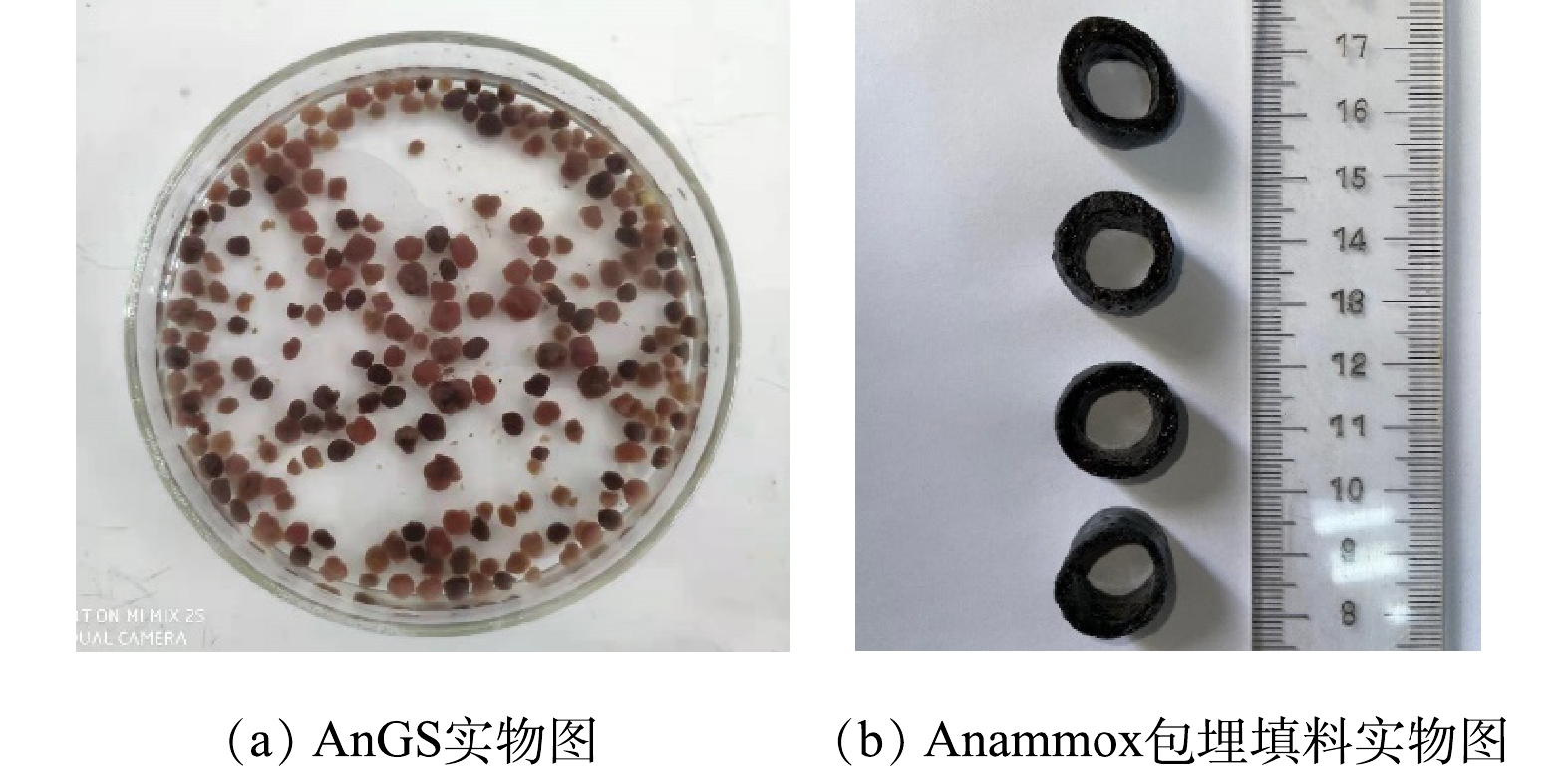
 下载:
下载:
